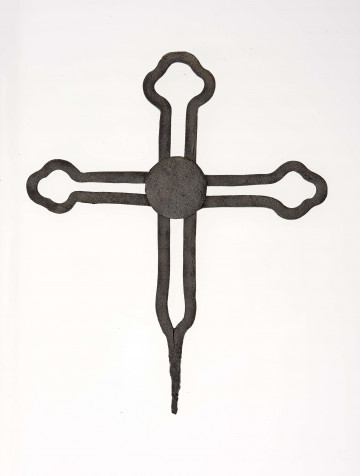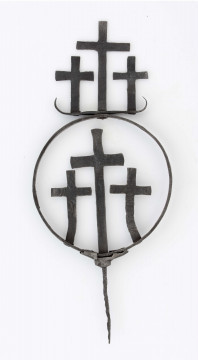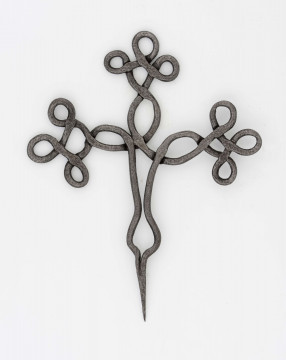
Cross
1901 — 1920
National Museum in Lublin
Part of the collection: Folk craft of the Lublin Region (19th/20th c.)
Folk blacksmithing was for a long time almost the only supplier of iron products, mainly tools necessary for rural households. Village or small-town blacksmiths also made religious items - iron crosses placed on tombstones, cemetery gates or tops of roadside shrines and crosses. They were characterised by simplicity of form and composition. Some of them were distinguished by artistry, visible in a variety of ways of ending the arms, which took the shape of, among others: small crosses, lilies, triangles, leaves, trillium, circles, rhombuses, hearts or slits turned outwards (see E/6390/ML). The silhouette of the cross sometimes included additional elements, such as rays, a central shield or ring, a cockade on top, and a halo or crescent at the base (see E/5520/ML, E/8115/ML).
Crosses with rays and a cockerel were not widespread in the Lublin region. The tin figure of a crowing bird was placed on the top of a vertical arm either permanently or movably on an axis as in windlasses, thanks to which it rotated under the influence of the wind. The figure of the symbolic hen usually took on a realistic form, but there were also far-reaching stylisations and simplifications resulting in an unspecified bird (see E/379/ML). Especially with older specimens it is difficult to verify whether this was an intentional artistic act or the result of blacksmithing skills.
In the Lublin, Lubartów and Łęczna region, crosses with a crescent have an additional decorative element in the central part, a halo, often surrounded by metal stars, which makes them resemble a monstrance.
Author / creator
Dimensions
cały obiekt: height: 38,5 cm, width: 88 cm
Object type
cross
Technique
forging
Material
iron
Creation time / dating
Creation / finding place
Owner
The National Museum in Lublin
Identification number
Location / status

1901 — 1920
National Museum in Lublin

1863 — 1868
National Museum in Lublin

1901 — 1920
National Museum in Lublin
DISCOVER this TOPIC
Castle Museum in Łańcut
DISCOVER this PATH
Educational path